#objectum virgil
Text
virgil having a crush on his CD player is something that can be so personal
#whats the. the meme#did i say it right#im worried im not remembering the wording right jajdjfjf#im such a boomer <- is 24#posic sides#objectum sides#posic virgil#objectum virgil
1 note
·
View note
Text


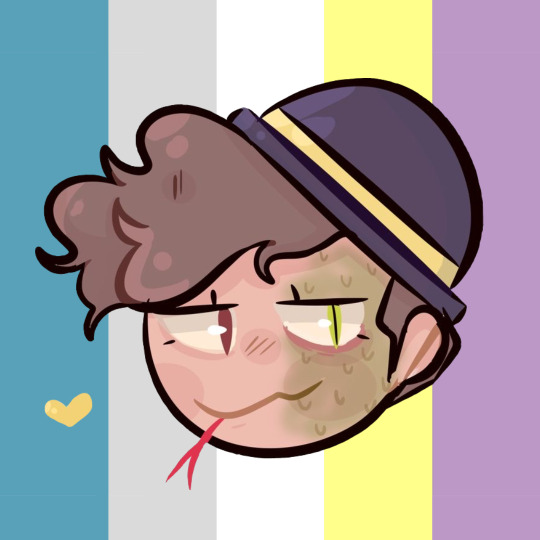






Some Sander Sides objectum pfps! with a few extra Janus ones cuz im kin of him lol
#sander sides#janus sanders#deceit sanders#remus sanders#virgil sanders#patton sanders#roman sander#logan sanders#objectum#familial objectum#platonic objectum#romantic objectum#posic#osor#objecto
26 notes
·
View notes
Text
I just think Virgil should get to fuck Logan while they wear her hoodie and nothing else. As a treat
#theynre objectum and virgil is dating the. hoodie also#goodluckhearts#tbh i think the clothes sharing is depraved w these two but im too embarrassed to talk abt it rn#give me a few more hours of sleep depravity and ill get back to you
0 notes
Text
ok look. virgil is objectum and in love with his skateboard AND HERES WHY: im in love with mine ajhdjdjd
#theyre just like me fr#i didnt think i was objectum until i met my skateboard <3#sanders sides#virgil sanders#posic sides agenda
1 note
·
View note
Text
Still thinking about Virgil objectum thoughts but I can't really word any of them properly. Maybe ill just draw it instead?
0 notes
Text
Conceptum Logan . Autosexual Roman. Fictosexual Patton. Fictoromantic Remus. Objectum Virgil thats attracted 2 personal objects. Objectum Janus thats attracted to public objects.
1 note
·
View note
Text

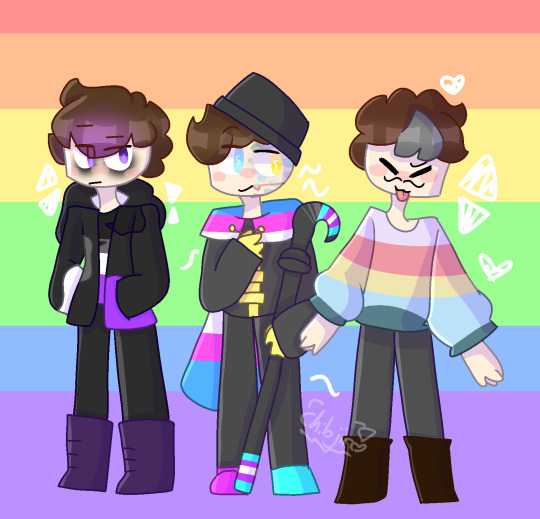
pride sides, babey!!!!
so
NB logan, gay roman (obviously), bi patton, ace virgil, trans janus, objectum pan remus!!
#art#sanders sides#virgil sanders#patton sanders#roman sanders#logan sanders#remus sanders#janus sanders#sanders sides fanart
222 notes
·
View notes
Photo

Stanning the Ancients.
Valerie Complex probes the intersection of Greco-Roman mythology and queer experience in Portrait of a Lady on Fire, The Neon Demon, Jumbo and Midsommar.
Ancient stories have a way of influencing modern filmmakers—in part because of their “glorious” approach to love, as actor, writer and Greek-myth-lover Stephen Fry noted at this year’s digital Hay Festival. But even beyond depictions of same-sex love, Greco-Roman mythologies lend themselves well to tales of otherness and transformation.
Mythology isn’t just a bunch of stories from thousands of years ago—it’s something we create every day. Greco-Roman mythology, in particular, has less to do with the “godly” part of the pantheon, and more with their human qualities. Their lust, jealousy, wrath and greed: on display for not just other gods but all mortals under them. These stories were a portal for us to reckon with the less-savory parts of ourselves.
More than that, these stories were a cipher; a way for us to relate to one another without the need for conversation. What are celebrities and the gossip they inspire, if not modern myths? Stans are acolytes worshipping at the temples of their respective gods. They make offerings, pray to them, build altars. Every celebrity’s past is of great interest to their worshippers, who mine their back-stories for nuggets of relatability.
Beyond direct adaptations (Jason and the Argonauts, Clash of the Titans and the like), these ancient myths have informed many recent films (Prometheus and The Lighthouse; the Amazons and Wonder Woman; Oedipus and Old Boy; Homer’s The Odyssey and O Brother, Where Art Thou? included). But queer scholars have long seen Greco-Roman myths as having a particular way of helping shape queer cinematic experience, because they exist at the same intersections.
Consider the queer sensibilities in the tall tales that feature trans and intersex characters, and all the other ways the ancient poets encompass LGBTQIA expression: through their tales of otherness, outcasts living on the fringes of society, relationships that reject heteronormativity, or that push the bounds of sexuality and identity.
When myth and movie come together to create loose adaptations, film lovers are blessed with art like The Neon Demon, Jumbo, Midsommar and Portrait of a Lady on Fire. Let’s look at how Ovid, Euripides and Virgil have woven their way into the fabric of each of these stories. (Spoilers ahead!)
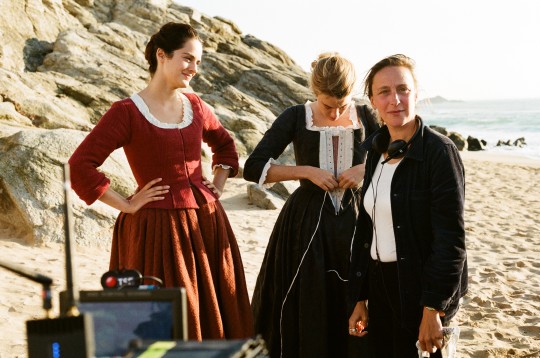
Noémie Merlant, Adèle Haenel and writer-director Céline Sciamma on the set of ‘Portrait of a Lady on Fire’ (2019). / Photo by cinematographer Claire Mathon, courtesy of NEON
The Melancholy Experience of Finite Love and the Desire of the Gaze: Céline Sciamma’s Portrait of a Lady on Fire meets Virgil’s ‘Orpheus and Eurydice’
Virgil’s story of Orpheus and Eurydice is woven so literally and metaphorically into Céline Sciamma’s Portrait of a Lady on Fire that it’s interesting to discover how late in the piece it came. Sciamma told me in an interview at the Toronto International Film Festival in 2019 that the story was one of the last elements to be included in the script. When she re-read the myth, she felt it ran perfectly parallel to Marianne and Hëloise’s relationship because the concept of gaze is extremely important for both couples.
In Virgil’s tale, it was prophesied that the marriage of Orpheus and Eurydice would be short-lived—and so it was. Eurydice dies from a snake bite, and her soul is sent to Hades. While in mourning, Orpheus gets the attention of the gods by singing and playing the lyre.
Being the rule-breaker that he is, Orpheus travels to the underworld to bring Eurydice back. Hades and Persephone are moved by his music and grant his wish that he will reunite with his wife, instructing him to keep his eyes front while his wife walks behind him into the living world. Unfortunately, he turns around—and loses her forever. We don’t know why he turned around when he was told not to—did he make the poet’s choice, or the lover’s? Perhaps the memory of Eurydice felt more feasible than having her physically.
In Sciamma’s film, Marianne (the painter), Hëloise (her subject) and Sophie (the maid) are isolated on a small island in eighteenth-century France. The trio carve out a microcosmic community where they are equal peers and status has no power. Hëloise reads the story of Orpheus to her two friends; they discuss whether he makes the poet’s choice, or the lover’s choice. Marianne and Hëloise engage in a romantic relationship, subverting the hostile, patriarchal world they live in. When their time is finally up and Marianne is running to the door to leave, Hëloise requests she turn around to see her one last time, thus imprinting a lasting image in Marianne’s mind. No one dies in their story, but, with a look, their love for one another lasts beyond the physical world.
Watch: Céline Sciamma discusses the myth of Eurydice and Orpheus in this clip from the new Criterion release of Portrait of a Lady on Fire.

Elle Fanning as Jesse in ‘The Neon Demon’ (2016).
Reflections and personae in The Neon Demon: Nicolas Winding Refn takes on Ovid’s ‘Echo and Narcissus’
The harsh modeling world is the perfect backdrop for The Neon Demon, which deals with ideals of beauty, deceit and narcissism. The film is also a loose adaptation of the Roman poet Ovid’s story of Echo and Narcissus from Book III of Metamorphoses. Narcissus is the beautiful hunter who upsets Aphrodite when he rejects a low-level goddess in the most asshole-y way. She curses him, and he ends up drowning when he falls in love with his reflection and tries to kiss it over a pool of water.
In The Neon Demon, Jesse (Elle Fanning) wants to be fashion’s next ‘it’ girl. She has youth and beauty on her side, which invokes jealousy in others. As her star rises, Jesse is consumed by vanity. After her harsh rejection of make-up artist Ruby (Jenna Malone), and going on an egomaniacal tirade, she is pushed into an empty pool by Ruby’s friends Sarah (Abbey Lee Kershaw) and Gigi (Bella Heathcote), thus breaking her neck.
Two stories from different millennia share a common thread: characters who love themselves to death (literally). What separates them is the queer subtext, particularly in The Neon Demon. Does Refn know his film had queer subtext? Perhaps not, though the film itself is often included in modern queer horror lists. There is an explicit attraction between the main characters, and he does an excellent job examining what that looks like when they are clouded by envy. For the women, this desire manifests in the form of companionship (Ruby), status (Gigi) or consumption (Sarah). This queer interpretation aids Refn’s exploration of relationships that exists outside of the typical portrayal of female desire.
There is a debate among viewers regarding the queer subtext and the lesbian body horror aspects of the film. Many of the film’s critics denounced the level of sexual objectification of the young women. However, objectification is a hallmark of the story: it’s a movie about the modeling world. What people miss is not only how the external world oversexualizes these characters, but how they objectify one another, and that gaze lends itself to a strong queer asthetic.
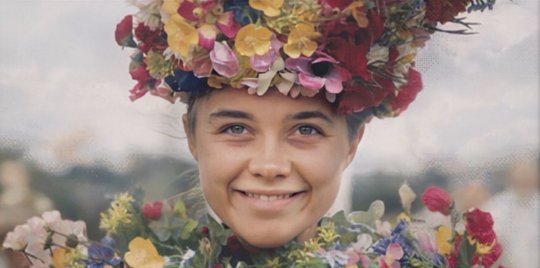
Florence Pugh as Dani in ‘Midsommar’ (2019).
Outcasts and killer cults in Sweden: Euripides’ The Bacchae as told through Ari Aster’s Midsommar
In Greek tragedy The Bacchae, Dionysus tells the citizens of Thebes he is the son of Zeus. No one believes him. He is gaslit to the point of shame. With his reputation in a shambles, the spurned demigod leaves Thebes. He soon returns in disguise with a pack of rabid women who call themselves the Bacchae—they kill King Pentheus and burn Thebes to the ground because they didn’t listen. No-one listens to Midsommar’s main character, Dani, either.
Dani is in an emotionally abusive relationship with the gaslighting Christian, and is surrounded by Christian’s friends who reject her and see her as an emotional burden. Imagine how unhappy they are when Dani accompanies them on their trip to Sweden to visit the commune of the Harga people for their Midsummer celebration. Things spiral out of control when Dani unintentionally rises to godlike status within the Harga cult, which leads to, let’s just say, consequences for her dissenters.
On its surface, Midsommar is not queer cinema—at the center of the film is a heterosexual couple. However, Dani is an emotional outcast and feels like an outsider no matter where she is; it’s an echo of queer experience that is heightened when the women of the Harga embrace Dani. She gains status within the group and receives cathartic support from the young women of the commune. This allows her to purge the toxicity she’s experienced at the hands of Christian, his friends, and the outside world.
Sure, the Bacchae and the Harga are both dangerous, insular, microcosmic communities. Those attributes aside, these are two groups that exist separate from society at large, because their way of life is unique only to them.
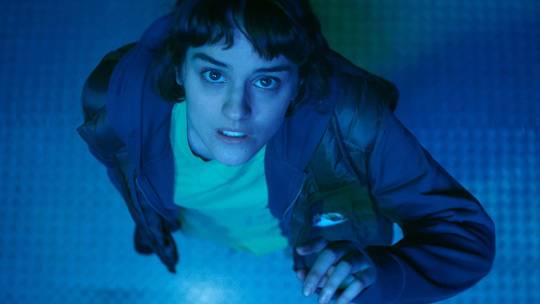
Noémie Merlant gazes up at the object of her desire in ‘Jumbo’ (2020).
The Allure of Inanimate Objects: Zoé Wittock’s Jumbo vs Ovid’s ‘Pygmalion’
Another story from Ovid’s Metamorphoses features Cypriot sculptor Pygmalion, who swore off women in his city and took to isolation. In his time away from society, he carved a woman out of ivory and fell in love with it. He prayed to Aphrodite to bring the sculpture to life—and she did! Could this be an early case of objectum sexuality? While there is no divine intervention in Jumbo (which premiered at Sundance this year), Zoé Wittock’s film explores the meaning of objectum sexuality, which is a form of sexual or romantic attraction focused on particular inanimate objects.
In the film, Jeanne (Noémie Merlant—yes, Portrait of a Lady on Fire’s Marianne) isn’t interested in human interaction, other than with her mother Margarette (Emmanuelle Bercot). Working for the cleaning crew at an amusement park, she falls in love with the newest attraction, a tilt-a-whirl ride named Jumbo. As Jeanne’s desire grows, the ride comes to life and begins to communicate via colors and sounds.
Jeanne is a societal outcast who rejects human romance; her relationship with Jumbo subverts what society understands about sexuality and connection. Coming out to her mother about her attraction is also a challenge. Margarette isn’t open to what her daughter is feeling and reacts harshly toward Jeanne by coercing her into engaging in sex with men, and, when that doesn’t work, throwing her out of the house.
Eventually, Margarette realizes love is love, and as long as her daughter isn’t hurting anyone, she can learn to accept Jeanne’s love for Jumbo. Being pushed to the fringes of society for being honest (like Jeanne), or isolating yourself (like Pygmalion), is a scenario that queer folks are all too familiar with. At least Jeanne and Pygmalion don’t face tragic ends. The odds of being rejected by loved ones is high.
Coming out to family members is hard enough, especially when your very existence challenges their sense of normalcy. But this is why chosen families are important, and in both stories, the love of an accepting, chosen few is better than the approval of the majority.
Related content
Follow Valerie on Letterboxd
Valerie interviews “Celine the Machine” at the Angelika in New York earlier this year.
Portrait of a Lady on Fire director Celine Sciamma answers your questions in our Letterboxd Q&A.
Jumbo and Portrait of a Lady on Fire star Noémie Merlant answers our Life in Film questions.
Midsommar director Ari Aster talks pagan rituals and psychedelic drugs in a Letterboxd Q&A.
MundoF’s essential list Opening the Vault: A Chronological History of Queer Interest & LGBTQ+ Cinema.
The Top 100 Narrative Feature Films by Women Directors
The Top 100 Women Directors of the 2010s
The 2010s—Top Romance Films
#valerie complex#queer cinema#lgbtqia#lgbtqia cinema#the neon demon#portrait of a lady on fire#midsommar#jumbo#noemie merlant#celine sciamma#nicolas winding refn#ari aster#zoe wittock#sundance#cannes#greek myth memes#greek mythology#greco-roman#roman myth#roman mythology#orpheus#euridyce#narcissus#ovid
15 notes
·
View notes
Text
virgil has a crush on his skateboard because im projecting as usual <3
0 notes
Text
virgil? dating his hoodie? its more likely than you think
0 notes
Note
NBLW Virgil with their trans wife logan
SO FUCKING REAL theyre both objectum lesbians and they're fucking nasty rn. Trust me I'm an objectum lesbian myself
#lesbian analogical <33#neith is writing a oneshot for them actually teehee ill ask if he wants to post it here#goodluckletters
3 notes
·
View notes
Text
Virgil listened to music through his headphones named Archer. He wore his hoodie, Parker. He was happy with his QPPs.
Virgil began playing a love song and put his hands in his pockets. He smiled to himself. He was in heaven.
this is all i have written for my objectum virgil fic but it’s cute so take it
3 notes
·
View notes
Text
Currently obsessed w the concept of logan finding out he's objectum through virgil- accidentally catching virgil fuck one of his object partners (a cd player maybe?) through an open crack in his door, talking to it in a low tone, and being......flustered beyond hell confused. He can't stop thinking about it for the next few days, no matter how hard he tries, so when he sneaks into virgils room to take a look at the cd player he tells himself it's just to satiate his curiosity, really, just so he can get back to work, just so his thoughts aren't so distracting, ignoring the way he flushes and gets hard when he's prodding at the buttons and thumbing the wires. And when he brings it closer, starts grinding against it and seeing the sparks and hearing the whirrs, he tells himself it's just because he wants to understand, wants to know why it had virgil panting and whining (much like he is, now), wants to know if it makes virgil feel as good as he feels now
1 note
·
View note
Note
On the subject of objectum sides, Virgil x his jacket is the cutest thing ever
SO REAL ....
0 notes
Text
for that au, i think there’s gonna be plot a and plot b. plot a is like. exploring logans posic… nature? and exploring his dynamic with his hoarde. plot b im not sure about. i just know i don’t want the fic to just be “logan is posic”
so i need something to be going on in logans life. maybe he’s in college? college AUs are nice. or maybe he lives with his family and there’s something going on there? im really not sure
also,, should i have logan also be objectum and end up dating (most likely) virgil? cos i don’t want shipping to be the core of this au but we need objectum fics that aren’t satire or made out to be cursed
ughhhhhh kajdkdjd the life of a writer
1 note
·
View note
Text
More objectum sides!!!
#i love logan x deadlines /g ik its a big joke in the fandom cuz u guys hate objectum ppl or whatever#but i love objectum ppl and objectum sides and conceptum logan is 1 of my biggest hcs#revy.txt#more objectum sides !!!#janus dating his hat. virgil dating his eyeshadow#polyamorous relationship between roman logan n crofters
10 notes
·
View notes